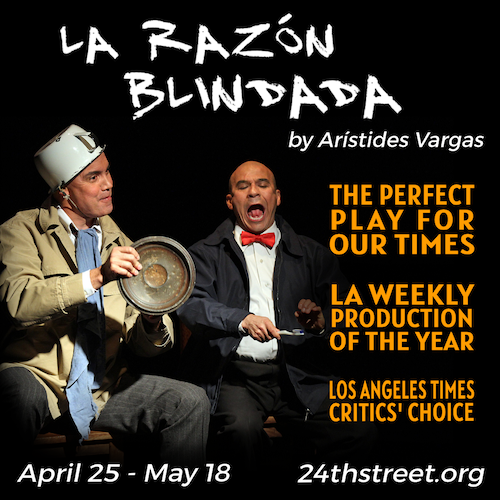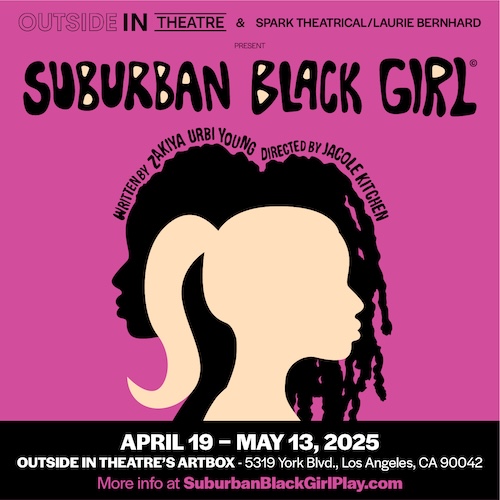According to the Chorus
Reviewed by Deborah Klugman
The Road Theatre on Magnolia
Through Dec. 11
Arlene Hutton’s new dramedy, According to the Chorus, promises much. Set in 1984 and billed as a fly-on-the-wall peep at the rivalry between a group of Broadway chorus dancers and the women who dress them, the play also touches on the loss and grief of the AIDS epidemic, as well as the heartache of its central character, KJ (Samantha Tan) a woman grieving her broken marriage to a man she still loves.
Hutton’s playwriting gifts gleamed eloquently in her sterling trilogy Last Train to Nibroc (memorably staged by director Nan McNamara at Actors Co-op in 2006). Set after World War II and later in the 1950s, in Kentucky and Florida, this trilogy follows the meeting and subsequent marriage of a young couple of that time and place, its narrative powered around these strong empathetic characters who reflected the mores of that era and the constraints its gender roles placed on both women and men.
In According to the Chorus, KJ, fresh off a job with the opera, is hired as a third dresser for a Broadway musical that’s been running for eight years. The responsibilities of this job— taking care of the dancers’ costumes and making sure the performers are properly attired before they go on stage — have to date been divided between the fractious Brenda (Amy Tolsky) and the smug Audrey (Avery Clyde). Both are seasoned veterans of their profession, with a distinctly admonishing attitude towards the younger women whose garb they maintain. Brenda is an especially difficult personality, one of those people always swift to find fault with others, while stubbornly blind to her own shortcomings. Even though KJ is razor sharp and learns quickly, Brenda concocts the fantasy that this new dresser is somehow inept.
The six women in the chorus are of different height, hair color and complexion but — and here we have one of the play’s major weaknesses— there’s not a lot else in terms of dramatic conflict to make them interesting. The closest one comes is with Stacie (Mara Klein), a battered woman who eventually goes to stay with KJ as she fights to stay free, psychologically and otherwise, of her abuser. (But even this subplot is underdeveloped — more a topic of conversation for the other women than a fleshed-out opportunity for the actor).
When they’re not complaining about Brenda or Audrey or the limitations of the changing room, these dancing ladies engage in riffs: searching obsessively for chocolate, or muttering about one’s mortgage, or gossiping about men. Their dialogue, however — more suggestive of the stereotypical clueless chorus girls of the 1950s than the more woke women of the 1980s — isn’t particularly comic or insightful, and one grows restless waiting for something to happen, either to KJ in relation to her ex, Peter (Juan Pope) who is an actor in this production, or with Brenda, fiercely critical of KJ at every turn.
Directed by Emily Chase, the production features several solid performances that keep one tuned in, despite a periodic urge (driven by the prattle of the chorus) to let one’s mind wander. Tolsky as Brenda, Clyde as Audrey and Tan as KJ are all good. Tan captures KJ’s intelligence, patience and vulnerability, while Tolsky and Clyde are equally persuasive (and entertaining) as self-righteous know-it-alls (who, on the other hand do have some right on their side in their squabbles with the narcissistic dancers). As the injured Stacie, Klein proves capable, though her role, like the rest of the chorus, is underwritten.
Pope — portraying Peter, KJ’s estranged but still caring spouse —is a bit too aloof. Here, as in her trilogy, Hutton juxtaposes the story of two ordinary folk against the backdrop of historical events — in this case, the AIDS crisis and its toll on the gay community and artists in particular. Though their marriage will never be mended, there’s a deep love between KJ and Peter. We need to see more of this element if the play is ever to attain full poignancy.
Hutton’s denouement also leaves the impression of things left out — interchanges between KJ and the chorus women which might have led to this final scene (with its aura of unkindness) seem to have been cut. This reinforces the impression of a work with a promising premise, meaningful themes, and plum roles for women that’s still a couple of versions short of stage readiness.
Paul Dufresne’s scenic design, lit by Derrick McDaniel), is a competent semblance of a cluttered backstage changing room (though little is altered when the setting shifts from a larger theater to a smaller one). Costumer Michele Young contributes a potpourri of colorful garb for the dancers; Judi Lewin’s hair, wig and makeup design add gaudy flash. At interims Christopher Moscatiello’s sound and Arian Saleh’s original music reflect that mix of buoyancy and blues that attend lives dependent on a living theater.
According to The Chorus The Road Theatre, 10747 Magnolia Blvd., N. Hollywood. Fri.-Sat., 8 pm, Sun., 2 pm; thru Dec. 11. www.RoadTheatre.org. Running time: approximately 95 minutes with no intermission.












